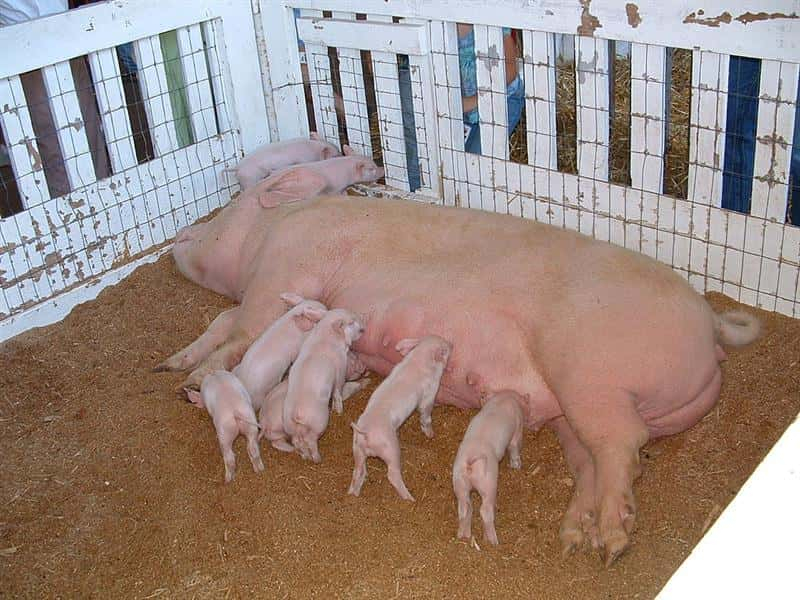Cheryl Anderson, DTN Staff Reporter
OMAHA (DTN) — The recent outbreak of porcine epidemic diarrhea virus in the U.S. could put a serious dent in hog production and slaughter through 2014, according to a recent report by Rabobank.
The report states that, to date, PED has affected approximately 60{75f28365482020b1dc6796c337e8ca3e58b9dd590dc88a265b514ff5f3f56c30} of the breeding herd in the U.S., about 28{75f28365482020b1dc6796c337e8ca3e58b9dd590dc88a265b514ff5f3f56c30} of the herd in Mexico and has begun to spread in Canada.
The spread of PED at its current rate could result in a 12.5{75f28365482020b1dc6796c337e8ca3e58b9dd590dc88a265b514ff5f3f56c30} decline in North American hog slaughter compared to 2013, or a drop of almost 18.5 million hogs. Rabobank projects U.S. pork production could decline as much as 6{75f28365482020b1dc6796c337e8ca3e58b9dd590dc88a265b514ff5f3f56c30} to 7{75f28365482020b1dc6796c337e8ca3e58b9dd590dc88a265b514ff5f3f56c30} in 2014, marking the largest fall in production in 30 years.
In the U.S. alone, PED could cause as much as a 12.5 million drop in market hogs in 2014, which constitutes about 11{75f28365482020b1dc6796c337e8ca3e58b9dd590dc88a265b514ff5f3f56c30} of the annual U.S. slaughter or approximately 12.5 million hogs.
Rabobank Analyst William Sawyer commented, “Given the ever-rising number of PED cases reported, coupled with a six-month average lifecycle, the months of August through October are likely to be the tightest for processors, where slaughter could decline by 15{75f28365482020b1dc6796c337e8ca3e58b9dd590dc88a265b514ff5f3f56c30} to 25{75f28365482020b1dc6796c337e8ca3e58b9dd590dc88a265b514ff5f3f56c30} against 2013 levels. If the virus continues at its current rate, the shortfall to U.S. slaughter in 2014 could be as much as 15 million hogs.”
The PED virus spreads rapidly through hog herds, typically via livestock or farm equipment used in contact with hogs with PED or their feces. Experts have not found the specific origin of the strains of PED spreading through the U.S., although they are similar to strains found in China.
Affected hog producers having difficulty eradicating the virus will likely experience significant financial losses from dwindling margins associated with long periods of decreased productivity. Profitability will likely decrease for packers as well, as shortages may cause plants to idle.
The PED-induced difficulties in the hog industry may be good news for the U.S. poultry industry to take advantage of the loss in production.
Rabobank estimates U.S. chicken production would need to increase 8{75f28365482020b1dc6796c337e8ca3e58b9dd590dc88a265b514ff5f3f56c30} to 9{75f28365482020b1dc6796c337e8ca3e58b9dd590dc88a265b514ff5f3f56c30} to make up for the decreased pork and beef production; however, growth could be restrained by a smaller breeding flock and high demand for fertilized eggs from Mexico. The report predicts that this, combined with increasing chicken prices and margins, could result in a profitable year for U.S. chicken producers.
DTN Livestock Analyst John Harrington said he agrees PED will be a huge production problem for the North American pork industry, but said the report has a lack of specific information, as reliable PED data is nearly impossible to gather yet.
“Rabobank's study is certainly a reasonable attempt to assess the death loss and production loss potential through the balance of 2014 and into 2015, but even these guys know that many assumptions made are little better than shots in the dark,” Harrington said.
However, Harrington did say he believe Rabobank correctly underscores the significant price potential in the hog market due to devastation from PED.
“Whether its final cutout of 2014 commercial production is closer to 5{75f28365482020b1dc6796c337e8ca3e58b9dd590dc88a265b514ff5f3f56c30} or 15{75f28365482020b1dc6796c337e8ca3e58b9dd590dc88a265b514ff5f3f56c30}, I don't think anyone knows at this point,” he said. “Studies such as this one at least give us a place to start.”
Harrington said it will be necessary to continually adjust predictions as actual slaughter data and other sources of information become available, such as Friday's USDA Quarter Hogs and Pigs Report.
© Copyright 2014 DTN/The Progressive Farmer. All rights reserved.
Posted with DTN Permission by Haylie Shipp




